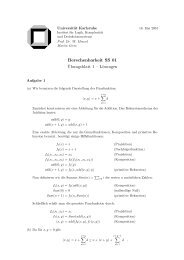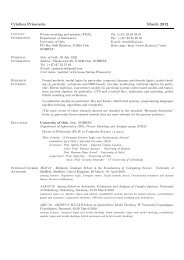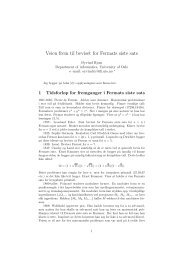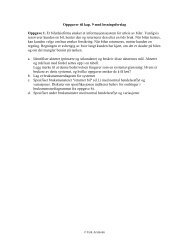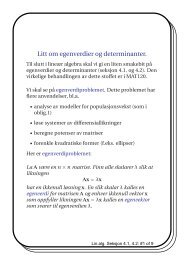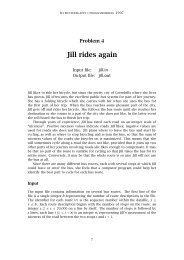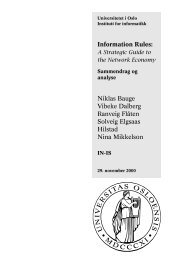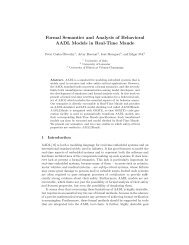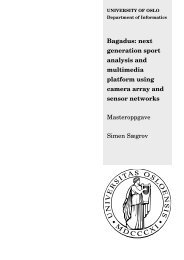Timed CTL Model Checking in Real-Time Maude⋆ - IfI
Timed CTL Model Checking in Real-Time Maude⋆ - IfI
Timed CTL Model Checking in Real-Time Maude⋆ - IfI
You also want an ePaper? Increase the reach of your titles
YUMPU automatically turns print PDFs into web optimized ePapers that Google loves.
24 D. Lepri, E. Ábrahám, and P. Cs. Ölveczky<br />
F<strong>in</strong>ally, all states with <strong>in</strong>dices from v to (k + v − 1) <strong>in</strong> π ′ i satisfy ϕ1,<br />
s<strong>in</strong>ce they also appear <strong>in</strong> π ′′<br />
j before the <strong>in</strong>dex k. We have already<br />
shown above that the states with <strong>in</strong>dices up to v also satisfy ϕ1,<br />
therefore the bounded until is satisfied along the path π ′ i .<br />
(ii) Otherwise mu¯r is the f<strong>in</strong>ite upper bound of I. Note that k > 0<br />
implies mu > 0. We assume first d π′<br />
j<br />
k ∈ I2 = (mu¯r − d2, mu¯r] and<br />
cover d π′<br />
j<br />
k ∈ I1 = I\I2 <strong>in</strong> case (iii).<br />
Let π ′ be the concatenation πpre′ and π ′′<br />
j<br />
j . The state tπ′<br />
k appears <strong>in</strong><br />
π ′ j by assumption at a time po<strong>in</strong>t <strong>in</strong> (mu¯r − d2, mu¯r], and therefore<br />
also <strong>in</strong> π ′′<br />
i at a time po<strong>in</strong>t <strong>in</strong> (mu¯r, mu¯r + d2] and <strong>in</strong> π ′ at time po<strong>in</strong>t<br />
((n + mu)¯r + d1, (n + mu)¯r + d1 + d2].<br />
By construction π ′ j conta<strong>in</strong>s the state t∗∗ at time po<strong>in</strong>t mu¯r − d2.<br />
Aga<strong>in</strong> by construction, also π ′′<br />
i conta<strong>in</strong>s t∗∗ at time po<strong>in</strong>t mu¯r −d2 +<br />
d2 = mu¯r. Therefore, the state t∗∗ appears also <strong>in</strong> π ′ at time po<strong>in</strong>t<br />
(n + mu)¯r + d1.<br />
We conclude that both t π′<br />
j<br />
k and t∗∗ appear <strong>in</strong> π ′ with<strong>in</strong> the time<br />
<strong>in</strong>terval ((n + mu)¯r, (n + mu + 1)¯r). From T K, t π′<br />
j<br />
k |=c ϕ2 we get<br />
therefore by <strong>in</strong>duction T K, t ∗∗ |=c ϕ2 .<br />
S<strong>in</strong>ce t ∗∗ appears <strong>in</strong> π ′′<br />
i at time po<strong>in</strong>t mu¯r be<strong>in</strong>g the upper bound of<br />
I, also the time bound of the until is satisfied for t ∗∗ on π ′′<br />
i .<br />
We have shown above that all states with <strong>in</strong>dices up to v <strong>in</strong> π ′′<br />
i satisfy<br />
ϕ1. The rema<strong>in</strong><strong>in</strong>g states preceed<strong>in</strong>g t ∗∗ <strong>in</strong> π ′′<br />
i also satisfy ϕ1, s<strong>in</strong>ce<br />
they appear <strong>in</strong> π ′ j before the <strong>in</strong>dex k. Thus the <strong>in</strong>dex of t∗∗ <strong>in</strong> π ′′<br />
i<br />
satisfies the condition of the bounded until on π ′ i .<br />
(iii) For the case d π′ j<br />
k ∈ I1 = I\I2 we observe that t π′′<br />
i<br />
l<br />
j<br />
= tπ′<br />
l−v<br />
for all l ≥ v.<br />
Therefore, T K, t π′<br />
j<br />
k |=c ϕ2 implies T K, t π′′ i<br />
k+v |=c ϕ2. S<strong>in</strong>ce d π′<br />
j<br />
k<br />
∈ I2<br />
we have d π′<br />
j<br />
k ≤ mu¯r − d2 and thus d π′′<br />
i<br />
j<br />
k+v = dπ′<br />
k + d2 ≤ mu¯r, i.e., the<br />
duration of π ′′<br />
i until the (k + v)-th state is below the upper bound of<br />
I. It is easy to see that this duration is also above the lower bound<br />
(d π′ j<br />
k<br />
i<br />
j<br />
is above the lower bound and dπ′′<br />
k+v = dπ′<br />
k + d2 > d π′ j<br />
k ).<br />
We have shown above that all states with <strong>in</strong>dices up to v satisfy ϕ1.<br />
Furthermore, T K, t π′ j<br />
l |=c ϕ1 implies T K, t π′′ i<br />
l+v |=c ϕ1 for all l < k.<br />
Therefore, the <strong>in</strong>dex (k + v) is appropriate to show that the path π ′′<br />
i<br />
satisfies the bounded until property.<br />
Based on the above lemma we ga<strong>in</strong> our completeness result:<br />
Theorem 1. Assume a time-robust real-time rewrite theory R whose time doma<strong>in</strong><br />
satisfies the theory GCD-TIME-DOMAIN. Let Π be a set of tick-<strong>in</strong>variant<br />
atomic propositions, and assume a protect<strong>in</strong>g extension of R def<strong>in</strong><strong>in</strong>g the atomic<br />
propositions <strong>in</strong> Π and <strong>in</strong>duc<strong>in</strong>g a label<strong>in</strong>g function LΠ. Let t0 be a state of R, r<br />
a non-zero time value of sort <strong>Time</strong>, ϕ a T<strong>CTL</strong>cb formula over Π, and assume



